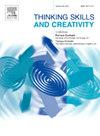A bibliometric and content analysis of educational robotics’ impact on communication, collaboration, critical thinking, and creativity in kindergarten
IF 3.7
2区 教育学
Q1 Social Sciences
引用次数: 0
Abstract
Communication, collaboration, critical thinking, and creativity are 21st-century skills required to be developed in educational settings from an early age. Robotics seems to contribute to that. Therefore, this study focuses on kindergarten and explores the current research trends regarding children’s development of these skills via robotics. It aims to a) construct links between the main factors in the existing research, b) map the related field, and identify gaps to enhance our understanding. In this context, a bibliometric analysis using the Bibliometrix package and CiteSpace and a content analysis utilizing the Atlas.ti Software is employed covering 203 of 3822 studies conducted between 2014 and December 2024. Based on the findings, the most frequently examined topics are social-anthropomorphic robots, human-robot interaction, and computational thinking under the umbrella of educational robotics and skills development. The highest publication performance belongs to the USA, Italy, Japan, China, and Greece. The strongest sources are ACM, IEEE International Conference on Human-Robot Interaction, the Education and Information Technologies Journal, the International Journal of Child-Computer Interaction, and the Computers and Education Journal. Besides, Papert, Wing, and Bers arise as the most influential authors. Furthermore, most studies explore one or two C-skills, examining critical thinking the most and creativity the least during interventions focused on several domains but rarely on skills promotion. Moreover, most researchers choose the qualitative method, using small sample sizes, wheeled, floor robots, and various learning theories in short-term interventions. Finally, robots are utilized as assistive instruction kits, teammates, and educators’ assistants while children act as researchers-constructors.
教育机器人对幼儿园沟通、协作、批判性思维和创造力影响的文献计量学和内容分析
沟通、协作、批判性思维和创造力是 21 世纪需要在教育环境中从小培养的技能。机器人技术似乎有助于这方面的培养。因此,本研究以幼儿园为重点,探讨当前通过机器人培养儿童这些技能的研究趋势。其目的是:a)构建现有研究中主要因素之间的联系;b)绘制相关领域的地图,并找出差距,以加深我们的理解。为此,我们使用 Bibliometrix 软件包和 CiteSpace 进行了文献计量分析,并使用 Atlas.ti 软件进行了内容分析,涵盖了 2014 年至 2024 年 12 月期间开展的 3822 项研究中的 203 项。研究结果表明,在教育机器人学和技能开发领域,最常见的研究课题是社交拟人机器人、人机交互和计算思维。发表论文最多的国家是美国、意大利、日本、中国和希腊。文章来源最强的是 ACM、IEEE 人机交互国际会议、《教育与信息技术杂志》、《国际儿童-计算机交互杂志》和《计算机与教育杂志》。此外,Papert、Wing 和 Bers 是最有影响力的作者。此外,大多数研究探讨的是一种或两种 C 技能,在侧重于多个领域的干预过程中,对批判性思维的研究最多,而对创造力的研究最少,但对技能提升的研究却很少。此外,大多数研究人员选择定性方法,在短期干预中使用小样本量、轮式落地机器人和各种学习理论。最后,机器人被用作辅助教学工具包、队友和教育工作者的助手,而儿童则充当研究者--建构者。
本文章由计算机程序翻译,如有差异,请以英文原文为准。
求助全文
约1分钟内获得全文
求助全文
来源期刊

Thinking Skills and Creativity
EDUCATION & EDUCATIONAL RESEARCH-
CiteScore
6.40
自引率
16.20%
发文量
172
审稿时长
76 days
期刊介绍:
Thinking Skills and Creativity is a new journal providing a peer-reviewed forum for communication and debate for the community of researchers interested in teaching for thinking and creativity. Papers may represent a variety of theoretical perspectives and methodological approaches and may relate to any age level in a diversity of settings: formal and informal, education and work-based.
 求助内容:
求助内容: 应助结果提醒方式:
应助结果提醒方式:


